![]()
| In Auto Focus mode: |
In Manual Focus mode:: |
The LED display system inside the viewfinder usually is the medium to bridge the photographer and the camera. It should be easy to understand and navigate. The AF in/Out of focus signals are position at the bottom left hand section. |
|
|
||
|
|
||
|
|
The Maxxum 7000 display system fits perfectly right under the base section of the viewfinder. The location of the LCD has proved to be one of the non-distracting segment inside the viewfinder of the picture frame. This allows the photographer to have a quick access to relevant information without the hassle of checking from the viewfinder. In relation to various exposure modes, the LCD will change in its display accordingly to reflect the mode in use.
![]()
| Over Exposure Warnings: |
Under Exposure Warnings: |
|
|
|
||
|
|
||
|
|
 |
|
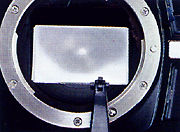 |
The bright Acute Matte focusing screen of the Minolta 7000's viewfinder is made up of some two and a half million microscopic lenses which are conically shaped to provide superior light dispersion, resulting in an extremely bright, clear and crisp viewfinder image. |
In addition to the standard Type G screen, three (3) optional, user-Interchangeable Acute-Matte focusing screens are also available specifically designed for the Maxxum 7000.
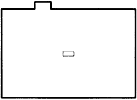 |
Type G: standard screen: for general photography |
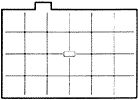 |
Type L: for general, close-up and telephotography. |
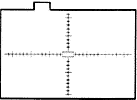 |
Type S: for general, macro, micro and astrophotography. |
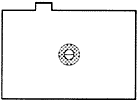 |
Type PM: for general photography with manual focusing. |
Other Minolta 7000 features
![]()
 |
Provides a ten second delay marked by a three-step, blinking, front-mounted LED accompanied by an audible warning. Self-timer operation may be canceled at any time by pressing the drive mode key. |
An audible warning alerts you if blur caused by either camera shake or subject movement is imminent. This warning varies with the focal length of the lens in use and takes place at the speeds below:
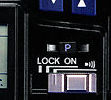 |
* 1 /30 sec. (shorter than 35mm) |
![]() This convenient
switch, located slightly below and to the left of the lens mount, allows you to switch
between autofocusing and manual focusing modes.
This convenient
switch, located slightly below and to the left of the lens mount, allows you to switch
between autofocusing and manual focusing modes.
![]() Comfortable hand grips on front and rear of the Minolta 7000 are integrated
into the camera's body to provide one-handed ease of handling and operation. The
hand grips also house the main power supply: four AAA-size 1.5v alkaline-manganese
batteries that power all camera functions.
Comfortable hand grips on front and rear of the Minolta 7000 are integrated
into the camera's body to provide one-handed ease of handling and operation. The
hand grips also house the main power supply: four AAA-size 1.5v alkaline-manganese
batteries that power all camera functions.
![]() Lets you instantly confirm whether film is loaded or not and what type
of film you're using.
Lets you instantly confirm whether film is loaded or not and what type
of film you're using.
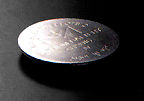 |
|
 |
|
 |
|
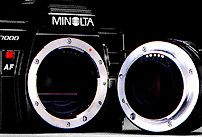 |
|
Previous | NEXT | 4/8
![]()
Specification | Main
Reference Map
Instruction
Manual
for Maxxum 7000
(6
Parts)
First Generation Minolta
AF Lenses
Minolta XD-7/XD-11 |
Minolta XK/XM/X-1 |
Minolta X-700 |
Maxxum
7000
| Maxxum 7000i
| Message
Board
| for Minolta X-700 | Maxxum 7000
| Maxxum 7000i
| Message
Board
| for
your Minolta optics in a shared environment
| Message
Board
| Specifically
for Dispose or
Looking for
Minolta Photographic Equipment
About this photographic site.
Home - Photography in Malaysia |
Credit: Mr Aaron Oh, for lending his old Maxxum 7000 brochure to prepare certain content appeared in this site; LEONID.SL<leonid.sl@prodigy.net> for his great image of the Maxxum 9000; Johannes Huntjens <yawngie@msn.com>, LT Jack B. Nunley <jnunley@insightbb.com> and "Jarret LaMark" <jlamark@wbhunt.com> huntsphotoandvideo.com for their generosity for granting permission to use some of the Maxxum 7000 images appeared in this site; Lapapl@aol.com for his image of the Minolta Maxxum 7000 AF Body / Program Back 70;"Camera Works" <cameraworks@qwest.net> for some superb view of the camera; Dan Dorsey <Fotowv123@cs.com> for his shots of the 7000 Body w/ Org. Box & Manual; "Rehmat Iqbal" <mimifour@hotmail.com><srafiq@houston.rr.com> for being so considerate and helpful. Certain content and images appeared in this site were either scanned from official marketing leaflets, Instruction Manual(s) & brochures published by Minolta and/or contribution from surfers who claimed originality of their work for educational purposes. The creator of the site will not be responsible for may discrepancies arise from such dispute except rectifying them after verification. "Minolta", "Rokkor", "X-700", "Dynax" & "Maxxum" are registered trade names of Minolta Optical Inc., Japan. A site dedicated to all Minolta fans worldwide. Site made with an Apple IMac.